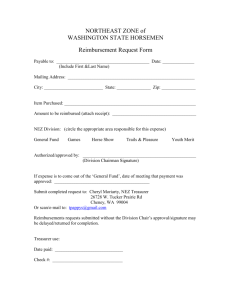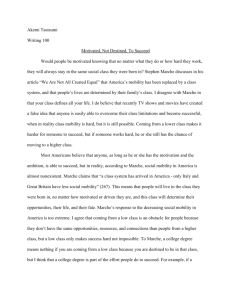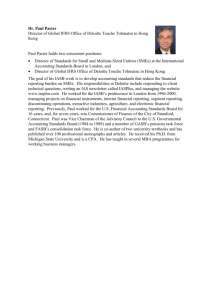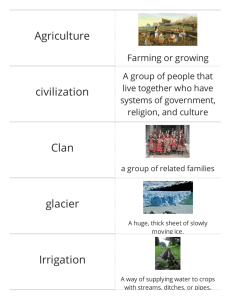TPR Lesson Demonstration One-Hour Lesson in French
advertisement
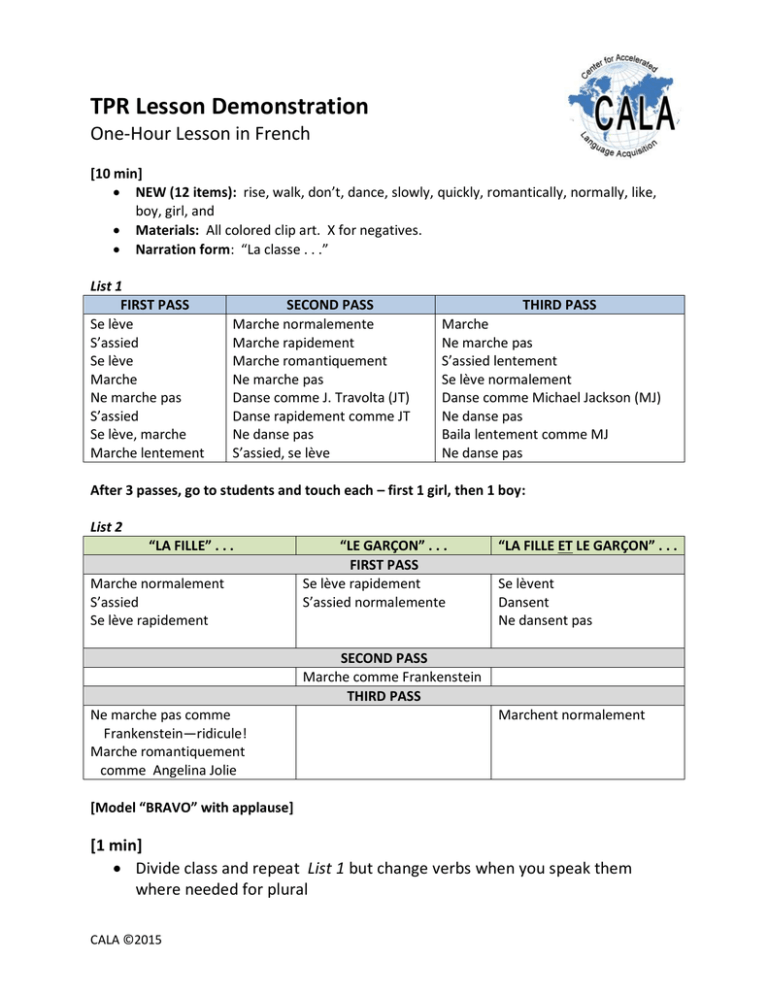
TPR Lesson Demonstration One-Hour Lesson in French [10 min] NEW (12 items): rise, walk, don’t, dance, slowly, quickly, romantically, normally, like, boy, girl, and Materials: All colored clip art. X for negatives. Narration form: “La classe . . .” List 1 FIRST PASS Se lève S’assied Se lève Marche Ne marche pas S’assied Se lève, marche Marche lentement SECOND PASS Marche normalemente Marche rapidement Marche romantiquement Ne marche pas Danse comme J. Travolta (JT) Danse rapidement comme JT Ne danse pas S’assied, se lève THIRD PASS Marche Ne marche pas S’assied lentement Se lève normalement Danse comme Michael Jackson (MJ) Ne danse pas Baila lentement comme MJ Ne danse pas After 3 passes, go to students and touch each – first 1 girl, then 1 boy: List 2 “LA FILLE” . . . Marche normalement S’assied Se lève rapidement “LE GARÇON” . . . FIRST PASS Se lève rapidement S’assied normalemente “LA FILLE ET LE GARÇON” . . . Se lèvent Dansent Ne dansent pas SECOND PASS Marche comme Frankenstein THIRD PASS Ne marche pas comme Frankenstein—ridicule! Marche romantiquement comme Angelina Jolie Marchent normalement [Model “BRAVO” with applause] [1 min] Divide class and repeat List 1 but change verbs when you speak them where needed for plural CALA ©2015 [2 min] “Please point to the picture I describe.” Hold up pictures and after class points, raise the correct one to verify correctness. [“Bravo! La clase dit bravo– thank you, please have a seat.”] [5 min] Request 4 volunteers - “Please hold these pictures at your chest and raise your when I describe it, then lower.” Always add one which is not there for fun. When no one responds say “Bravo! Good job – I couldn’t trick you” Request an additional 4 volunteers [2 min] NEW (4 items): head, nose, hand, touch Materials: Colored clip art for head, nose, hand. List 3 FIRST PASS SECOND PASS (repeat until no hesitation) Touche la tête Touche le nez Touche la main Lève la main THIRD PASS [1 MIN] [1 min] (divide the class – “¡Excelente!” when finished) Touche la tête lentement Touche le nez rapidement Ne touche pas le nez rapidement Touche la tête Touche le nez Touche la main Lève la main Touche la tête lentement Touche le nez rapidement Ne touche pas le nez rapidement [5 min] Whole group - Start adding Lists 1-2 to List 3 List 4 FIRST PASS La clase se lève Marche et touche la tête Danse et touche le nez S’assied et touche la main Se lève et lève la main Marche et touche le nez S’assied et lève la main CALA ©2015 SECOND PASS (do not model) Marche Ne marche pas S’assied Se lève Lève la main Touche le nez Lève la main NOVEL: Lève le nez (“Bravo!”) THIRD PASS -Touche la main -La main touche la tête -La main touche le nez -NOVEL: La main touche la main rapidement (“Bravo!”) Bravo! Divide –redo II and #2 [26 minutes for parts I and II ] [Part II pictures that need drawings done on clip art: ] hand dances. head and nose walk. Boy lifts hand. Girl lifts nose. Boy touches head. Girls touches nose. Hand walks. Head doesn’t walk. Hand raises the nose. Girl raises the boy. [15 min] Show funny pictures from group #2 and give verbal choices / 5 people up in front/ 5 more/describe easy pictures from group #1 on board and class shows response through raising fingers/then when it’s clear they have it, describe and they shout out number of what you’re describing [10 min] Tappette of easiest ones on board. Divide by counting 1,2. Two lines. Pairs up front. Give about 3-4 chances to each pair. No running. No scoring. [5 min] Assessment - These are ESL teachers so there is no common language among their students to do written assessments with. Assessment will be Describe pictures, they write numbers – correct together. Explain 80% rule. 56 minutes – [ 4 minutes -] Handouts CALA ©2015 Assessment TPR Demonstration 1. Michael Jackson marche lentement à Las Vegas. 2. La main y le nez dansent la cha-cha romantiquement. 3. Lady Gaga lève les mains rapidement. 4. Big Bird se lève et touche la tête. 5. El chico ne marche pas comme Frankenstein. 6. La fille danse et lève le nez. Listen to the French and write the number of the sentence you hear : Listen to the English and write the number of the sentence you hear: 1. ______ 1. ______ 2. ______ 2. ______ 3. ______ 3. ______ 4. ______ 4. ______ 5. _______ 5. ______ Teachers: One extra sentence is given above on purpose so that answers don’t come from simply process of elimination. If students are literate and the new language has the same alphabet as the native language, there is direct transfer of most vocabulary from auditory fluency to reading skills. The use of the absurd illustrates how the mind is capable of remixing old vocabulary to understand sentences with completely new meanings (a sign of fluency), even though the meanings are absurd. You’ll notice in the demo that people’s bodies will begin to do the absurd narration correctly, but their rational minds will make them hesitate; they don’t believe what they’ve heard. The use of games provides the safe trial and error context so necessary to grow dendrites, increasing the velocity at which the ear is capable of understanding the new language (another sign of fluency). Inserting things like plurals, adjectives, and cognates can serve as contextual clues to prime or pre-teach new grammar, providing a familiar aid for the future when new information needs a reference point to which it can run back and attach itself. Inserting famous people and students from the class is fun, helps grab attention, and makes this small assessment a pleasant learning experience. Short, daily assessments give the brain the quick feedback it wants and an opportunity for pop-up grammar lessons in context. This satisfies left hemisphere curiosity as is unconsciously compares L1 with L2 and confirms correctness (another sign of fluency) or need to change/adapt, a basic survival skill of the brain. CALA ©2015

